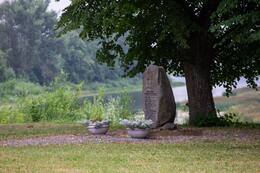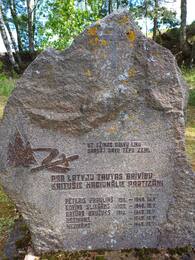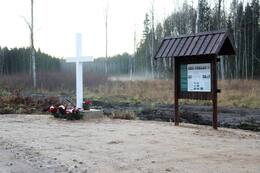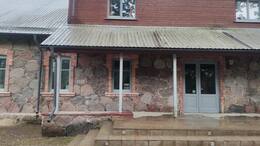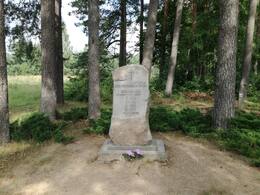Latvijos ir Lietuvos partizanų – miško brolių – kovų vietomis
Diena 1.
70 km
Jekabpilis - Akniste
Praktinė informacija
- Maršrutas skirtas kaip vadovas – kaip optimaliai keliauti po regioną ar šalį, arba dvi šalis, siekiant pažinti jų karinį paveldą;
- Vairuotojas turi pats suplanuoti – kiek iš rekomenduojamų objektų ir vietų jis gali apžiūrėti per vieną dieną;
- Prieš kelionę reikėtų pasitikrinti lankytinų vietų (muziejų, kolekcijų, įtvirtinimų ir kt.) darbo laiką;
- Vietose, kur būtina išankstinė rezervacija (vietiniai gidai, privačios kolekcijos ir kt.), apsilankymą būtina užsisakyti, nurodant datą ir laiką. Jei kelionė atšaukiama, apie tai reikia informuoti užsakytų vietų atstovus;
- Apgyvendinimą būtina užsisakyti iš anksto. Vasaros sezonu apgyvendinimo paslaugos gali būti neprieinamos, ypač pajūryje. Kai kurios maitinimo įstaigos žiemos sezonu gali nedirbti;
- Kelionei rinkitės ne tik vasarą, bet ir kitus metų laikus;
- Latvijos, Lietuvos ir Estijos sienas keliais galima laisvai kirsti be apribojimų ir bet kuriuo paros metu. Vykstant iš vienos šalies į kitą, būtina su savimi turėti asmens tapatybės kortelę arba pasą;
- Apsilankykite turizmo informacijos centruose, kur galite gauti papildomos informacijos, brošiūrų ir žemėlapių.
Lankytinos vietos
Atminimo akmuo Rihardo Pārupo nacionalinei partizanų grupei
Įsikūręs Rygos gatvėje, netoli Krustpilio liuteronų bažnyčios.
1996 m. rugsėjo 22 d. Krustpilyje buvo atidengtas atminimo akmuo Rihardui Pārupui ir jo vadovaujamai nacionalinei partizanų grupei. Atminimo akmenį sukūrė skulptorius Ilgvaras Mozulānsas, o jo sukūrimą finansiškai parėmė Saeimos pirmininkė Ilga Kreituse. Šį renginį organizavo Latvijos nacionalinių partizanų asociacijos valdyba.
Rihardo Pārupo nacionaliniams partizanams,
kuriuos nužudė Čekos specialioji grupė
Richardas Parupsas (1914 m. – 1946 m. liepos 2 d.)
Grupės vadas
Richardas Stulpinsas (1923–1946 m. vasario 7 d.)
Alberts Avotiņš (1912 m. – 1946 m. liepos 2 d.)
Erikas Juhna (1928 m. – 1946 m. liepos 2 d.)
Aleksandrs Lācis (1919 m. – 1946 m. liepos 2 d.)
Petras Lokys (1921–1946 m. liepos 2 d.)
Jānis Ēvalds Zālītis (Āboliņš) (1911 – 1946 m., liepos 2 d.)
Zygfridas Bimšteinas, Teodoras Šmidtas (… – 1946 m. liepos 2 d.)
Uldis Šmits (... - 1946. 2. VII)
Peteris Lazdanas (1926–1947)
Erikas Konvalis (1929 – 1947. VI)
Niklāss Ošiņš (1908 m. – 1954 m. spalio 12 d.) – įvykdyta mirties bausmė Rygoje
Albertas Čiķauka (1911–1972 II) – kalėjo Mordovijos stovykloje
Rihardas Pārupsas gimė 1914 m. birželio 11 d. Krustpilio valsčiaus „Kaķīšiuose“. Antrojo pasaulinio karo metu jis buvo 15-osios Latvijos divizijos prieštankinės divizijos seržantas. Dalyvavo nacionalinėse partizanų operacijose Jekabpilio ir Maduonos apylinkėse, buvo Nacionalinio pasipriešinimo judėjimo narys, būrio Jekabpilio ir Maduonos apylinkėse vadas. Rihardas Pārupsas žuvo mūšyje su Čekos kariuomene 1946 m. liepos 2 d. Vietalvos valsčiuje. Deja, palaidojimo vieta nežinoma. Rygos brolių kapinėse įrengta atminimo lenta. 1945 m. rudenį Jekabpilio rajone buvo suformuota nacionalinė partizanų grupė, vadovaujama R. Pārupo. Per savo trumpą gyvavimo laikotarpį ji dalyvavo daugiau nei dvidešimtyje ginkluotų susirėmimų su tuometinės Vidaus reikalų ministerijos daliniais. Čekos pulkininko Kotovo ataskaitoje Rygos vadovybei teigiama, kad dėl grupės veiklos šiuo laikotarpiu sovietų valdžios veikla Jekabpilio ir Maduonos rajonuose buvo faktiškai paralyžiuota. R. Pārupo vadovaujami nacionaliniai partizanai rado ir sunaikino kelis tremtinių sąrašus, taip išgelbėdami daugelio žmonių gyvybes. Saugumo komiteto vadovybė, negalėdama sunaikinti nacionalinių partizanų būrio atviroje kovoje, į jį infiltravo keturis Čekos specialiosios grupės asmenis, kurie sušaudė dešimt būrio partizanų, tarp jų ir R. Pārupą. 1947 m. netoli Jaunkalsnavos buvo sušaudyti dar du, o 1951 m. – vienas šio būrio narys. Po dvidešimt penkerių metų sunkaus darbo Mordovijos lageryje keturioliktas R. Pārupo vadovaujamos grupės partizanas mirė likus kelioms dienoms iki išlaisvinimo.
P. Praulinio nacionalinio partizanų būrio narių atminimo vieta ir bunkerio vieta
Pēteris Prauliņš (1911–1949) Biržų parapijos nacionalinis partizanų būrelis priklausė Mārtiņa Pokļevinskio (1902–1951) vadovaujamai grupei. Grupė vykdė keletą partizaninių akcijų, kurių metu buvo baudžiami sovietų kolaborantai, rekvizuojamas okupacinės valdžios ekonominių įstaigų maistas ir turtas. P. Praulinio grupės partizanai nesilaikė pakankamo sąmokslo principo, daugelis asmenų lankydavosi jų gyvenvietėje, o tai sudarė sąlygas išdavystei. Karinės patirties stoka buvo vienas iš partizaninio ginkluoto judėjimo trūkumų.
P. Praulinio partizanų grupė Kalnos miške Biržų valsčiuje buvo sunaikinta 1949 m. gegužės 16 d. Latvijos SSR Valstybės saugumo ministerijos operacijos, kurioje dalyvavo ir kariniai daliniai, metu. Miško broliai buvo įsirengę gerai užmaskuotą bunkerį su perimetro gynyba, kuris buvo įsikūręs nenustatytame aukštyje pelkėtoje vietovėje. Partizanai mažiausiai 40 minučių įnirtingai priešinosi Čekos kariuomenei, tačiau krito visa grupė: Pēteris Prauliņš, Artūras Bružukas, Jānis Kalvāns, Edvīns Slikšāns ir Francis Skromanis. Sušaudyti miško broliai buvo numesti netoli valsčiaus namų, tačiau jų palaikai vėliau buvo palaidoti netoliese esančiuose žvyrduobėse. Sunkiai sužeista buvo Irma Bružuka, kuri buvo paimta į nelaisvę ir mirė gegužės 17 d. Jekabpilio ligoninėje. Ji buvo palaidota už kapinių ribų, tačiau, kai kapinės buvo išplėstos po Latvijos nepriklausomybės atkūrimo, ant jos kapo buvo pastatytas paminklas.
1998 m. lapkritį buvo pašventintas atminimo akmuo P. Praulinio grupės partizanams Kalnos valsčiuje. P. Praulinio bunkerio vieta yra Vidsalos 99-ojo kvartalo 4 sekcijoje, Kalnos valsčiuje. Akmuo, ant kurio sėdėjo P. Praulinis, yra išsaugotas.
Atminimo vieta 1945 m. vasario 13 d. nacionalinių partizanų mūšio vietoje Kalnos parapijos Deimantų miške
Memorialinė vieta buvo sukurta rajoniniame kelyje P74 Siliņi – Aknīste, 12 kilometrų nuo Aknīstės, pasukus į Latvijos valstybinį mišką „Žagari kelias“.
Jau 1944 m. vasaros pabaigoje didžiulis Elkškių valsčiaus šiaurinės dalies miškų masyvas tapo žmonių, besiruošiančių ginkluotai kovai su sovietų okupacine valdžia, susibūrimo vieta. 1944 m. pabaigoje Aknystės apylinkėse pradėjo kurtis nacionalinių partizanų grupės. Tinkama vieta partizanų stovyklai įkurti buvo Deimantinis miškas , esantis Elkškių didžiojo miško pietiniame pakraštyje, netoli Aknystės Didžiosios pelkės. Ten, mažiau nei 10 kilometrų nuo Aknystės valsčiaus, nacionaliniai partizanai įrengė tris žiemos bunkerius žiemojimui. Miške susirinkusių vyrų susisiekimas buvo užtikrinamas padedant netoliese esančių namų – Baltimorės, Gargrodžių, Lyčių, Priedžių, Krūmų – ir kitų namų gyventojams, kaimynams bei partizanams.
Partizanų mūšis su Latvijos SSR Valstybės saugumo ministerijos kareiviais Deimantų miške įvyko 1945 m. vasario 13 d. Čekistai, paėmę įkaitus, juos nustūmė į priekį, kad atidengtų partizanų bunkerius. Miško broliai, pamatę pavojų, atidengė ugnį, negailėdami įkaitų. Mūšyje žuvo 10 sovietų okupacinių kariuomenės atstovų, aštuoni nacionaliniai partizanai ir keturi įkaitai. Nepaisant miško brolių nuostolių, čekistams nepavyko užimti partizanų bunkerių. Išlikę partizanai palaukė sutemų ir paliko gyvenvietę. Mūšyje sužeisti čekistų kareiviai, dejuodami, negalėjo palikti mūšio lauko. Po šio mūšio, kurį galima laikyti pirmuoju miško brolių „kovos krikštu“, partizanai jautėsi kaip broliai, o šautuvas atrodė brangesnis už viską, kaip vienintelis patikimas gelbėtojas.
Baltasis kryžius ir informacinis stendas Deimantų miške buvo įrengti Lačplėsio dieną – 2022 m. lapkričio 11 d. Atminimo vietos sukūrimą parėmė Jekabpilio regioninė valdžia, asociacija „Tēvzemes sargi“ ir Latvijos valstybiniai miškai. Informacinio stendo turinio autorius yra istorikas Haraldas Bruņinieksas.
Buvę Susėjos parapijos namai, nacionalinių partizanų išpuolio vieta 1945 m. liepos 7 d.
Šiandien buvusiuose Susėjos parapijos namuose įsikūręs Sanssouci rezidencijų centras. Pastato fasade vis dar matyti nacionalinių partizanų kulkų palikti pėdsakai 1945 m. liepos 7 d. puolimo metu.
Buvę Susėjos parapijos namai, tuo metu veikę kaip sovietų okupacinės valdžios vietinis vykdomasis komitetas, 1945 m. liepos 7 d. nukentėjo nuo Sėlijos nacionalinių partizanų išpuolio. Išpuolis prieš Susėjos vykdomąjį komitetą buvo platesnės nacionalinių partizanų kampanijos dalis ir vyko tuo pačiu metu kaip ir išpuoliai prieš Vilkupės sviesto fabriką bei naikintojo Kaunacko namą.
Susėjos nacionalinių partizanų grupės vado Alberto Kaminskio (1920–1946) nurodymu miško broliai turėjo sunaikinti vietos vykdomojo komiteto apsaugą, paimti ginklus, milicijos uniformas, dokumentus ir sugadinti telefono ryšį. Susėjos vykdomojo komiteto puolime dalyvavo apie 17 miško brolių, vadovaujamų Lietuvos partizanų vado Jozo Kuveikio. Mūšis truko 15–20 minučių, susišaudymo metu žuvo vienas Lietuvos partizanas, o kitoje pusėje – naikintojų bataliono Jānio Kakarano kovotojas. Susišaudymo metu buvo išdaužti vykdomojo komiteto langai ir apgadintas telefonas.
Antrasis išpuolis prieš Susėjos vykdomąjį komitetą įvyko 1945 m. liepos 16 d., kai vyko užsitęsęs susišaudymas tarp „Miško brolių“ ir naikintojų bataliono kovotojų, kurie buvo pasislėpę Vykdomojo komiteto pastate. Mūšio metu pastariesiems į pagalbą atėjo grupė sovietų kareivių, kurie iš flango atidengė kulkosvaidžių ugnį ir privertė partizanus trauktis. Mūšyje žuvo mažiausiai penki „Miško broliai“ ir penki naikintuvai. Išpuoliai prieš šį okupacinės valdžios administracinį objektą patvirtino partizaninio karo ginkluoto pasipriešinimo pobūdį ir buvo įspėjimas apie žmonių pasipriešinimą sovietų okupacinei valdžiai.
Susėjos nacionalinių partizanų paminklas
Susėjos nacionalinis partizanų būrys buvo suformuotas iš mažesnių suskaidytų miško brolijos grupių, nes iš pradžių nebuvo vadovo, kuris galėtų jas suvienyti. Trumpą laiką Artūras Grābeklis bandė koordinuoti Susėjos partizanų, o vėliau ir Markejaus Gorovniovo, žuvusio 1945 m. žiemą, veiklą. Susėjos nacionalinis partizanų būrys buvo sustiprintas po to, kai po visuotinės Vokietijos kapituliacijos į Kuršą, Sėliją, atvyko buvęs legionierius Albertas Kaminskis. Jis įvedė griežtesnę drausmę ir suvienijo mažesnes grupes bendrai kovai su sovietų okupacine valdžia. Taip pat buvo bendradarbiaujama su miško brolijos grupėmis iš netoliese esančių parapijų ir vietovių, ypač su Gārsenės grupe ir Lietuvos partizanais, kurie buvo įsikūrę Lietuvos ir Latvijos pasienyje.
Ankstyvaisiais ginkluoto judėjimo etapais akivaizdu, kad miško broliai nebuvo pasiruošę puolimams, negalėjo užimti nei Kaunackų sodybos, nei įsilaužti į Susėjos vykdomojo komiteto pastatą. Partizanai patyrė nuostolių ir ilgai negalėjo pasipriešinti Čekos kariuomenei, o pagrindinis kovos metodas buvo galvoti apie atsitraukimą laiku. Taip pat buvo problemų dėl partizanų aprūpinimo. Nepaisant esamų sunkumų, Susėjos nacionalinis partizanų būrys pirmaisiais pokario metais vis dar sugebėjo aktyviai priešintis sovietų okupacinei valdžiai. Ši partizanų grupė nustojo egzistavusi po jos vado A. Kaminskio žlugimo 1946 m. gegužės 14 d. Po to sekė ir kelių miško brolių legalizavimas, taip pat prisijungimas prie kitų partizanų grupių.
Paminklas Susėjos kuopos nacionaliniams partizanams atidengtas 1997 m. lapkričio 11 d. Sėlijos nacionalinių partizanų istorijos tyrinėtojo Gunāro Blūzmo iniciatyva. Šalia žuvusių Susėjos nacionalinių partizanų vardų, grubiai apdirbtame riedulyje po kryžiaus ženklu iškaltas tekstas: „Ant ežio galvos įsakiau tau saugoti tėvo žemę“. Paminkle minimi 1945 m. liepos 16 d. užpuolus Susėjos vykdomąjį komitetą žuvusieji – Jānis Grābeklis (1923-1945), Ādolfas Rācenis (1919-1945), Broņislavs-Arvīds Bīriņš (1919-1945), vėlesnis vardas9 (Edgars450-1) ir Edgars45. buvo pridėti nužudytieji Lina Kaminska (1917-1945) ir Albertas Kaminskas (1920-1946). Ant paminklo trūksta Arnoldo Dombrovskio (1923-1945) ir kitų Susėjos tautinių partizanų grupėse veikusių, 1945-1946 metais kritusių nacionalinių partizanų pavardžių.
Vietos pavalgyti
- Jēkabpilyje žr. visit.jekabpils.lv
- Kavinė „Kalniņa“ Aknīstėje
Vietos apsistoti
- Jēkabpilyje žr. visit.jekabpils.lv
- Liepos svečių namai ir maitinimo paslaugos, Aknīstė, https://www.celotajs.lv/lv/e/liepasalksnite




